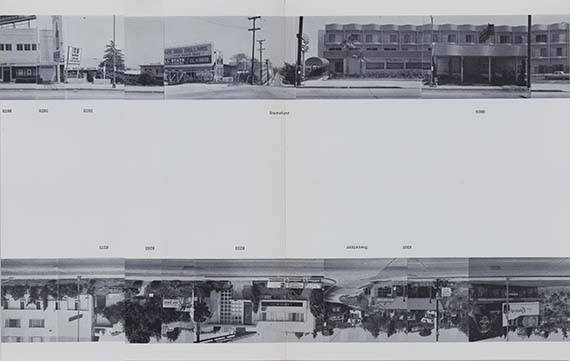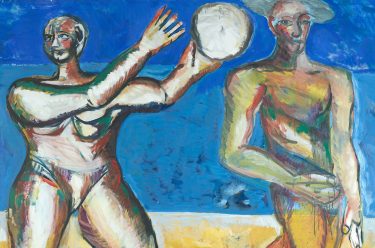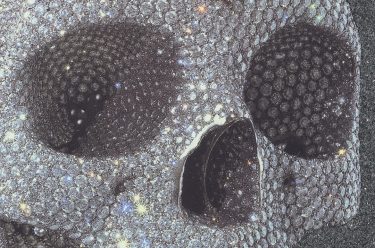
During ‘California Design 1930–1965: Living in a Modern Way’, complementary works by two Collection artists are on display in the Watermall, at the Queensland Art Gallery (QAG). Despite being separated by a generation, and by the expanse of the Pacific Ocean, the works of Scott Redford and Ed Ruscha echo similar sentiments about the culture and architecture of their coastal homes.
As Ed Ruscha arrived in Los Angeles, California, in 1956, Queensland’s Surfer’s Paradise was beginning its rise to national pre-eminence as the holiday destination of choice for Australians who could afford it. In emulation of the North American model in Florida, its first canal subdivisions were being approved by the Albert Shire Council, and multistorey motels were under construction, designed to entice Australian holidaymakers to the strip of beachfront that became known, in 1958, as the ‘Gold Coast’. The Queensland Government officially proclaimed the Gold Coast a city the following year.
The arrangement of works by Ruscha (b.1937) and Queensland artist Scott Redford (b.1962) in QAG’s Watermall during ‘California Design 1930–1965: Living in a Modern Way’ illustrates the similarities in their choice of motifs (signs, surf culture, vernacular architecture) as well as to their responses to particular urban milieus, resonant with local histories and anecdotes. Both artists make the prosaic into the iconic in response to their particular environments.
In 1956, Ruscha journeyed west via Route 66 from Oklahoma — where his family had moved in 1942 — to Los Angeles. There he attended the Chouinard Art Institute until 1960, before it changed its name to the California Institute of Arts. He found employment at an advertising agency for a short period, but saw the creative freedom of an artist as more rewarding and held his first solo show at the Ferus Gallery in 1963.

Much of Ruscha’s art is about being ‘on the road’ in America. The graphic visual environment of Los Angeles and southern California, with its advertising hoardings and neon signage was a constant source of interest for Ruscha. This culture of cars, highways, gas stations and road signs nourished his painting as well as his important photographic book works of the 1960s, such as Twenty-six Gasoline Stations (1963), Some Los Angeles Apartments (1965), Thirty-four Parking Lots in Los Angeles (1967), and perhaps his best known, Every Building on the Sunset Strip (1966).
Two suites of gelatin silver prints included in the Watermall display, Some Los Angeles apartments 1965/2003 and Vacant lots 1970/2003 (Paul Eliadis Collection of Contemporary Art, Brisbane), derive from Ruscha’s book works of the 1960s. The first numbered editions of these photographs were issued in 1989 and Ruscha has referred to the production of these limited‑edition prints as ‘raiding the ice-box’.
Vine intersects four other streets 2003 encapsulates much that is typical of Ruscha’s oeuvre. Santa Monica and Hollywood Boulevards, Vine Street and Sunset Strip are names that have been mythologised through films, novels, TV series, songs and products. The intersection of Hollywood Boulevard and Vine Street, for example, is steeped in LA folklore: ‘Hollywood and Vine’ is where the radio, movie and music industries established their offices and studios in the 1920s and 30s. Landmark sites, such as the city’s first high‑rise office (the Taft Building) and Capitol Records, are also located here. The art scene seamlessly merged with the world of night clubs, surfing, music, cars and street culture. Neither the Gold Coast nor Los Angeles were ever celebrated as bastions of high culture: both were vaguely seedy and dismissive of convention and authority, and both represented an opportunity for greater freedom. They were rock ‘n’ roll towns.

The Gold Coast that Scott Redford grew up in was, by the mid 1970s, a freestyle fusion of Miami, Las Vegas and Los Angeles, where a derivative modernist aesthetic had been shoe-horned into an ocean-side strip of high rises, hedonism and surf culture. Redford’s Miami High School song emulated the jaunty cadence of the Mickey Mouse Club theme song, and the school’s sign referenced the free-standing letters of the iconic Hollywood sign. The canary yellow of Redford’s Automatic for the people (SURF) 1997 is a kind of third-tier reference to both the Hollywood sign and to the reflective pool of imitation and derivation; this hybridisation continues in his Surf painting/Modernist house 2000, which draws on the styles of celebrated Californian émigré architects Richard Neutra and Rudolf Schindler, whose works merge for Redford with the 1950s and early 1960s houses on Broadbeach’s Old Burleigh Road. Proposal for a Surfer’s Paradise Public Sculpture/GC Cinemas 2006 is perhaps his most emphatic nod to the culture and architecture of mid-century California, meshed with private nostalgia and an homage to his hometown.
Despite being an ocean apart, the geographies and cultural identities of southern California and Queensland’s Gold Coast share much vibrant, ‘un-stuffy’ and fertile ground, especially for these two artists, who each embraced the contradictions and peculiarities of their time and place.


